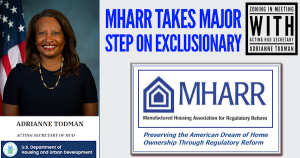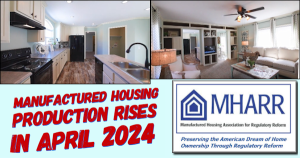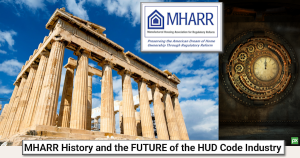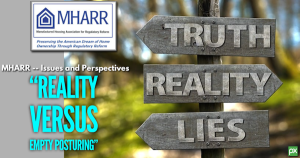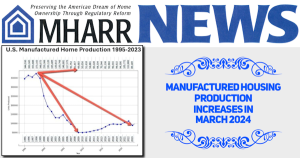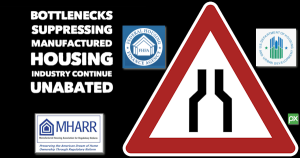August 2022 MHARR Issues and Perspectives – “WHY THE DOE ENERGY RULE SHOULD BE DOA”
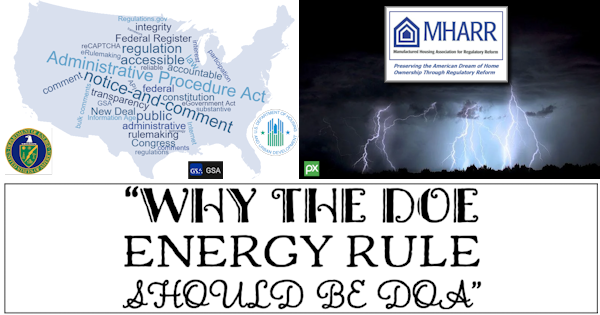
AUGUST 2022
“WHY THE DOE ENERGY RULE SHOULD BE DOA”
On May 31, 2022, the fifteen-year battle over U.S. Department of Energy (DOE) “energy conservation” standards for HUD Code manufactured homes came to a head as DOE published its final standards with full implementation scheduled for May 31, 2023. Not to put too fine a point on it, these standards are – and will be if not confronted, stopped and substantially modified – a disaster for the manufactured housing industry, consumers and the country, which faces an extreme and growing shortage of affordable housing. As a result, the industry and other stakeholders have less than a year (and, in reality, less than that) to take action to upend the DOE standards and send the DOE process back to the drawing board. Absent that, the destructive and discriminatory DOE standards will become a fait accompli, with further market-killing mandates spewing forth on a regular basis, as energy and climate special interests push the International Energy Conservation Code (IECC) – the statutory benchmark for the DOE standards — toward the holy grail of “net-zero” energy use. The question, then, is how can the DOE rule be stopped?
Any objective analysis of that question must be, first and foremost, grounded in reality rather than speculation or wishful thinking. In that regard, the Manufactured Housing Institute (MHI) – which made a crucial error in initially supporting the DOE rulemaking process – is now promoting legislation that would require DOE, among other things, to “fully consult with HUD” and require any DOE energy standards to be “adopted by HUD as part of the HUD Code.” While such legislation might have been useful at a much earlier stage, when MHI could have worked with MHARR (as it did on the 2000 reform law) to ensure legitimate and cost-effective standards, MHI’s delay in seeking such relief has given DOE and energy special interests the upper hand.
Put simply, it is highly unlikely that a legislative or Executive Branch remedy would succeed today, or in the near-term. Both the Biden Administration and the current majorities in Congress have made it clear that “climate change” and related energy consumption policies are among their highest priorities. This perspective will not change before the November 2022 midterm election and the seating of a new Congress in 2023. Therefore, any chance of enacting legislation or eliciting Executive Branch relief for the impending energy standards, at present, is virtually nil. After going to the effort to produce final standards under 15-year-old enabling legislation and a court-ordered deadline, and with energy and “climate change” activists poised to fight any implementation hiccup, neither the current Congress nor the current Administration is going to adopt legislation or support any remedy that would alter the status quo.
Unfortunately, the picture does not improve significantly even if the 2022 midterm election produces a change in control of one or both houses of Congress as some prognosticators suggest. A change in control of the House of Representatives, but not the Senate, would leave any remedial legislation in limbo. A change in control of both houses could conceivably lead to some type of relief legislation, but a presidential veto would be a virtual certainty. And, with a closely divided Senate (the likely outcome under any scenario) a veto override requiring 2/3 majority would be a non-starter. Consequently, the prospect of relief legislation becoming law prior to implementation of the DOE standards would be minimal, with virtually no possibility of Executive Branch relief.
Based on this analysis, the best prospect for timely relief from the DOE rule continues to be in the courts. And while judicial action has its own challenges, including cost, unpredictability and no guarantee of success, it is, at least:
(1) A forum that is available now;
(2) Which has the ability to act prior to the scheduled DOE implementation date;
(3) That could force either a “re-do” of the DOE rule or, at a minimum, set back the implementation timeline to a point when the prospect of obtaining either legislative or Executive Branch relief would be greater.
Conversely, a failure to act now to thwart the DOE rule would not only allow that rule to devastate the HUD Code market in the near-term, but also allow it to become the baseline for a non-stop parade of ever-more stringent and costly IECC-based energy standards for HUD Code homes under section 413(b)(3) of the Energy Independence and Security Act of 2007 (EISA).
Given these factors, what would a court challenge to the DOE rule look like? As with virtually all substantive federal rules, the DOE energy rule is subject to judicial review under the Administrative Procedure Act (APA). The APA provides, in part, that: “a person …adversely affected … by agency action within the meaning of a relevant statute, is entitled to judicial review thereof.” The APA, in turn, directs a “reviewing court” to “hold unlawful and set aside agency action” that is “arbitrary, capricious, an abuse of discretion, or otherwise not in accordance with law….” This authorizes a court to enter an injunction against enforcement of the DOE “final” standard and grant other relief, such as vacating the final rule and directing DOE to engage in a proper rulemaking consistent with EISA, including its cost-benefit and HUD/Manufactured Housing Consensus Committee (MHCC) consultation mandates.
Regarding the substance of such claims, while a multitude of theories are potentially available to assert the invalidity of the DOE energy rule, there are a number of claims that are more or less obvious based on written comments that MHARR has already submitted to DOE (and others) in connection with the rule. Those arguments are summarized below, but the list is by no means exhaustive.
The essential basis for a court challenge to the DOE rule, would be that the rule is “arbitrary, capricious and not otherwise in accordance with law” because of fundamental errors both substantively in the rule itself and procedurally in the DOE rulemaking. And while the APA “arbitrary and capricious” standard is itself “narrow” and relatively deferential to agency decision-making, there still must be, as recently noted by the Supreme Court, a reasoned basis for the choices made by DOE, a DOE examination of the “relevant data” and “a rational connection between the facts found and the choice[s] made” by the agency. In this matter, however, DOE’s final rule fails to meet the APA/EISA 413 standard in multiple respects.
First, EISA expressly requires DOE to consider the cost of any manufactured home energy standard and reject any standard that would not be cost-effective from either the standpoint of impact on the initial acquisition cost of the home or life-cycle construction and operating costs. This is particularly crucial for manufactured housing (the only federally-regulated segment of the housing industry), which is expressly recognized as affordable housing by federal manufactured housing law and subject to a strict cost-benefit balancing test under that law. DOE, however, cannot (and has not) made any such determination in this case because, as the full “cost” of any regulation necessarily includes regulatory compliance costs, and DOE has never calculated, estimated, or considered those costs.
Indeed, DOE has repeatedly admitted that it has not considered any of the regulatory compliance costs that will be necessitated by its final rule. Thus, while DOE asserts that its rule is “cost-effective when evaluating” its impact “on the purchase price of the manufactured home and on the total life-cycle construction and operating costs,” it acknowledges that it has not yet proposed a testing and regulatory compliance mechanism, and further admits that it has not considered the likely cost impact of those requirements on either regulated manufacturers or consumers. Regarding testing, DOE states: “DOE is not addressing a test procedure in this rulemaking. DOE will consider … test procedures, including an analysis of any related costs, in [a] future action….” Similarly, regarding enforcement, DOE states: “DOE is not addressing [certification, compliance and enforcement] issues in this rulemaking….” The DOE rule, therefore, includes no analysis of the likely cost(s) of testing, certification, compliance and enforcement in connection with the final manufactured housing energy standards.
To the extent that the alleged “cost” of the final DOE standards fails to include a fundamental and necessary cost element (i.e., regulatory compliance costs), the final standards cannot be shown to meet either the substantive cost-benefit criteria of EISA section 413, or the “arbitrary and capricious” standard of the APA.
Second, DOE’s alleged cost analysis fails to include or consider other major factors. The “costs” implicated by cost-benefit analysis and the “reasoned decision-making” mandated by the APA have been construed broadly by the courts. Indeed, the Supreme Court has stated that “any disadvantage” can be a “cost” that must be considered by an agency. Given this broad construction, the DOE rulemaking fails on multiple points already detailed in prior MHARR comments including, but not limited to:
(1) Its failure to properly consider the full cost of the exclusion of millions of potential purchasers from the HUD Code market due to excessive regulation-driven purchase price increases; and
(2) Its failure to consider the compliance cost and purchase price impacts of regulatory unpredictability and uncertainty flowing from:
(A) Ongoing IECC code changes; and/or
(B) Arbitrary and capricious DOE changes and modifications to IECC criteria based on its alleged “discretion” to alter those requirements.
Each of these failures, individually, would constitute a sufficient basis to overturn the DOE rule.
Third, DOE’s alleged cost-benefit analysis is fundamentally flawed in that it materially underestimates the severity and impact of inflation on both the cost of the final standards and the purchasing ability of manufactured housing consumers. For example, DOE’s August 26, 2021 Supplemental Notice of Proposed Rulemaking assumed an annual inflation rate of 2.33%, while its October 26, 2021 Notice of Data Availability reduced the assumed rate to 2.28%. Since that time, however, real annual inflation has soared to 9.1% and remains near its 40-year high. Actual inflation, accordingly, is more than four times the DOE “estimate,” with purchase price impacts that would materially exceed those estimated.
Fourth, as MHARR has extensively documented, DOE’s procedure in developing the final energy standards, from its scam “negotiated rulemaking,” to its phony and fundamentally tainted “Manufactured Housing Work Group,” to its selective leaks of key information, collusion with special interests and other deceitful steps, represents a completely separate basis for relief. While DOE, understandably, claims that its “negotiated rulemaking” process is in the rearview mirror, repeated references in the proposed and final rule to the conclusions of the negotiated rulemaking “Working Group,” tell a different story.
Fifth, but perhaps most important, is DOE’s failure to comply with EISA section 413 by failing to consult with HUD and the MHCC in a meaningful way at the beginning of the standards-development process, when such consultation might have had a beneficial impact in ensuring the consistency of DOE’s standards with the unique construction and role of manufactured housing as a source of affordable homeownership. Instead, and in violation of EISA, DOE came to HUD and the MHCC as an afterthought, not to substantively engage with either, but to conduct cursory briefings on a standard and a standards-concept that were already a fatally flawed fait accompli.
As noted above, these are just some of the claims that could be asserted against the DOE final rule in an appropriate court action. There are many others as documented by MHARR. And potentially, there are still others that could be explored and refined in the lead-up to a court action, including DOE’s citation of the Social Cost of Carbon (SCC) metric, even though DOE disingenuously denies any reliance on that guesswork masquerading as “science.”
But nothing will change without a court challenge to invalidate and enjoin the enforcement of the DOE “final” standard. Make no mistake about it. This standard, if left intact, will destroy key segments of the manufactured housing industry (especially small businesses and the industry’s most affordable homes) by causing prices to skyrocket while excluding millions of Americans from the market. And forget all the talk about energy subsidies, credits or offsets from an already bloated federal government. Talk is cheap, unlike the DOE standards. The industry, accordingly, is at a crucial crossroads. If it accepts its drubbing by DOE, the drubbing will never end. The results will be dire for many and fatal for some. Or it can fight the DOE rule in court. It won’t be easy and it won’t be cheap. But the alternative is worse and crunch time is fast approaching. The industry as a whole must be prepared to take this major step.
Mark Weiss
MHARR is a Washington, D.C.-based national trade association representing the views and interests of independent producers of federally-regulated manufactured housing.
“MHARR-Issues and Perspectives” is available for re-publication in full (i.e., without alteration or substantive modification) without further permission and with proper attribution






